EMERGENCE OF THE CITY-STATE
EARLY COLONISATION
Greek colonisation occurred in two stages. The first, centred around the 11th to 9th centuries, took the Greeks across the Greek mainland, the Aegean Islands and to Asia Minor. The second phase of colonisation was from the 9th to 6th centuries, and this phase took the Greeks right across the Mediterranean and Black Sea. The other main difference between the two colonisation phases other than locations was that the first consisted of tribes moving around local areas, whereas the second consisted of organised directions from the originating cities, and many of these colonies would go on to become their own city states, independent from their old home cities.
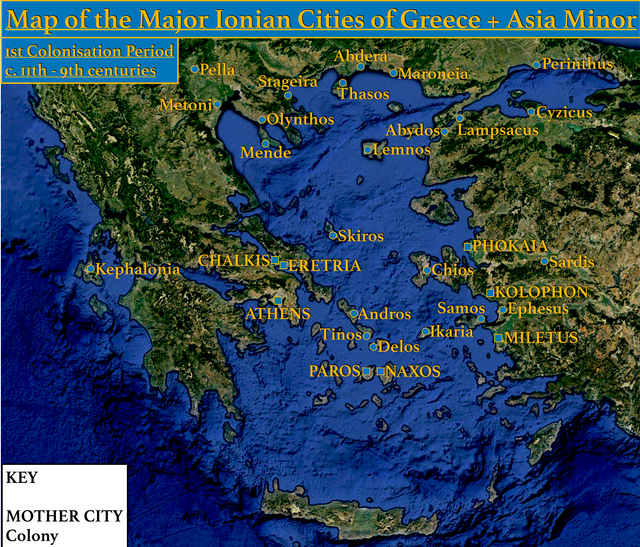
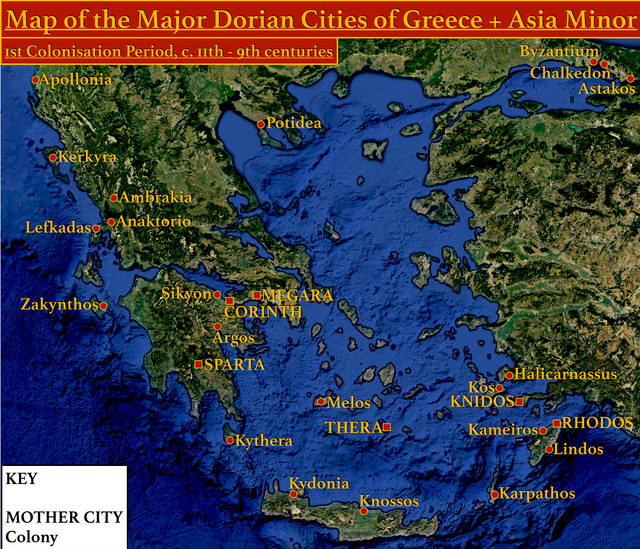
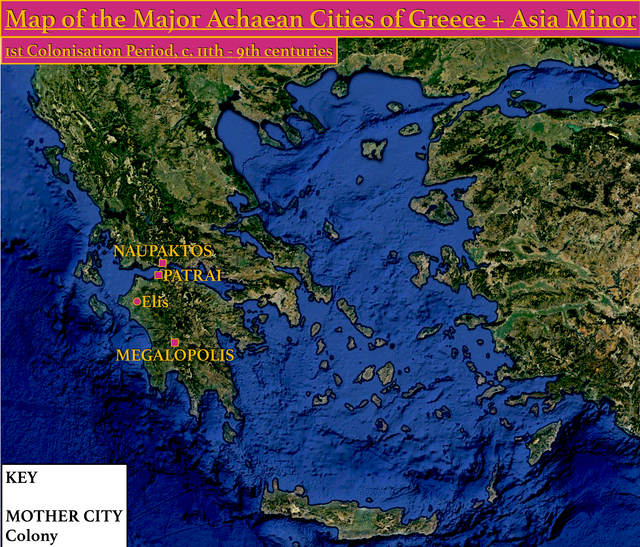
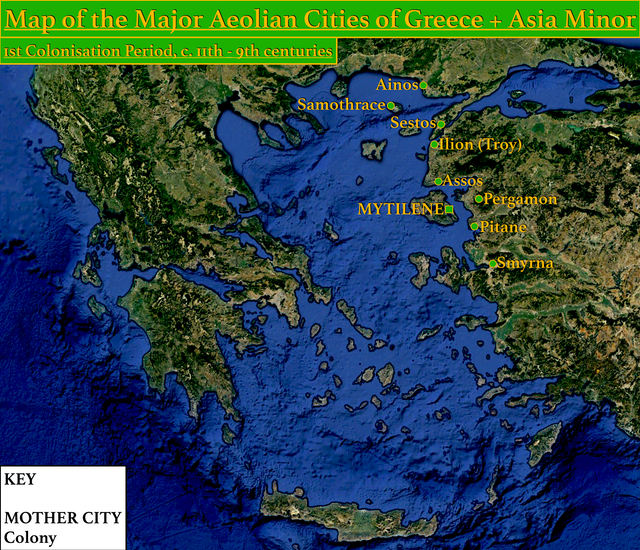
CITY STATES
Mogens Herman Hansen and his team at the Polis Centre at Copenhagen have identified 1,500 cities belonging to the Archaic Greeks, 600 of which lie in mainland Greece. Polis (plural: poleis) is a Greek word, meaning literally ‘city’. It was a typical community structure consisting of an urban centre (the astu), which was often fortified and built with a sacred/religious centre atop a natural acropolis, old Mycenaean citadel or a harbour. The Astu controlled surrounding rural land, called a chora, so the term Polis has been translated to mean ‘city state’. City states were independent from one another, and Greece as this time was definitely not a unified country; each state had its own legal, political, religious and social institutions and practices, and infighting between cities was common; Athens and Sparta, for example, would famously come to heavy blows in the 5th century BC in a series of three wars known as the Peloponnesian Wars. So each polis was its own state, and just like any other independent state, they were all each involved in their own international affairs, whether with other poleis or any non-Greek states, dealing with politics, trade and war. Other cultures across the world had a similar system, like the Etruscans in northern Italy, the Phoenicians in Lebanon and the Babylonians in Iraq. While the Greeks shared a common language and religious beliefs and deities, each city state also had their own form of currency, and their own patron deity.
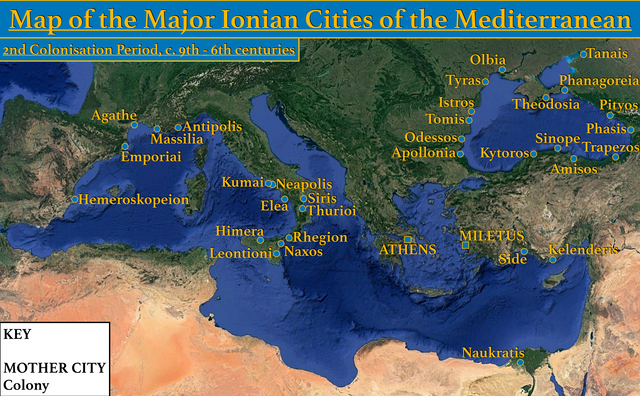
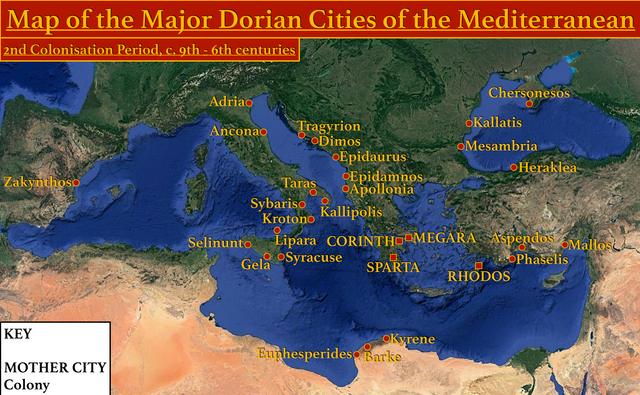
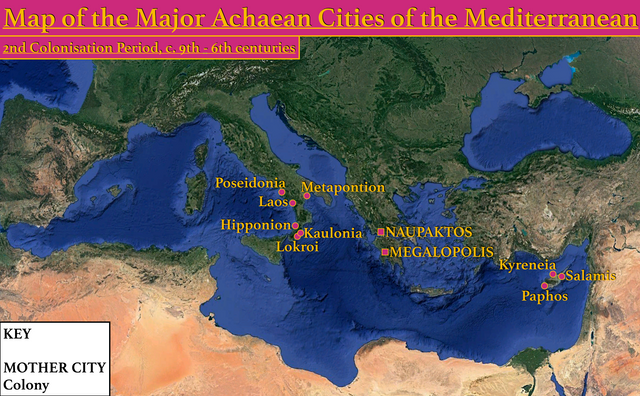
COLONISATION TRENDS
First and foremost, Greek colonisation was mostly coastal, and a quick glance at a map of Greek colonies clearly shows this. It’s where the colonisers would have landed first of course, but it also meant that sea trade was easier, as was the movement of armies whenever needed. Inland colonisation was done too, but it was harder, especially when these Greeks came into contact with local ‘barbarian’ tribes, like the Thracians and Dacians to the north of mainland Greece. Colonising the coast would have also allowed the Greeks to gain access to, and trade, both inland and sea resources, improving trade potential even further. Cities growing in population and a growing want for far-off resources would have prompted the need for colonies. An example of a luxury trade resource were murexes, large marine snails used to extract crimson dye.
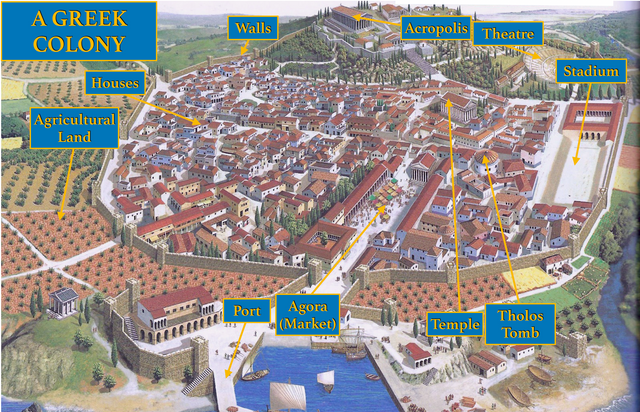
POLIS RELIGION
Perhaps the most key way that Greeks openly expressed their membership to a city-state was through shared religious acts. These included festivals, processions and sacrifices. Polis religion, the basic unit to social and political life, operated on three levels of Greek society: within the oikos (household), within the polis itself and on the Pan-Hellenic dimension, at sanctuaries like Delphi and Olympia. While Greece itself during the Archaic Period and onwards was not a unified nation (at least until the Roman period), religious inventories closely resembled each other for the most part due to the Greeks having a mostly shared past; All Greeks for example were polytheistic, meaning they worshipped more than one deity, as opposed to being monotheistic, that is, worshipping only one deity. In particular, the poems of Homer and Hesiod had unified and formed the structure of the Greek Pantheon, thus religion offered common sets and values and ideologies, such as shared notions of purity and pollution, sacred and profane, human and divine, reference points across the Greek world. The Greeks believed that if they wanted something from their gods, they would firstly have to offer them something first in the form of an animal sacrifice. Most sacrifices included cattle, sheep and goats.
RELIGION AT HOME
Religion within the oikos is what you could consider the basic unit of Greek society. In Attic culture, the oikos referred to the line of descendants, from fathers to sons. Aristotle alternatively used the term in his “Politics”, referencing to every individual living in a home. Larger oikoi also had farms mostly tended to by slaves, and were the basic agricultural unit of the Greek economy.

ABOVE: A typical/ideal layout of a Greek home
• Andron - Male entertainment room
• Gyneceum - Female entertainment room
• Oikos - Family room
A Greek house would also typically contain the following:
• Naos - Sacred enclosure
• Temenos - Sacred enclosure
• Hieron - Sanctuary/holy place
• Bōmos - Altar
• Sacred caves/groves/springs
• A festival, with an aition (myth explaining origin to the beliefs in the gods), procession, act of carrying + a ceremony for a particular individual/group at the house
DEITIES
Deity is simply the collective word for god and goddess, and the Greeks worshipped several of them, each for different purposes. City temples would house the statue of one or more deities, and would be decorated with relief scenes depicting myths and legends surrounding those particular figures. Divine figures like these could also be found on coinage, as well as drinking cups and other vessels and pottery. Greek deities depicted in sculptures or reliefs with certain items could tell you about them, such as how Athena was often depicted with a shield (relating to war) and an owl, which the Greeks related to wisdom. And the same deity could be the patron deity of several different city states at once, and each state would sometimes refer to them in different ways, attributing one of the deities known traits to their own state far more than that deities other traits, and as a result deities would almost have certain powers and spheres of influence depending on where they were worshipped.
The most notable of the Greek pantheon included:
• ZEUS - King of the gods and ruler of Mount Olympus. God of the sky, weather, thunder and law and order.
(Patron God of Elis and Olympia)
• HERA - Queen of the gods. Goddess of marriage, women, birth, heirs, kings and empires. Wife of Zeus
(Patron Goddess of Argos and Samos)
• APHRODITE - Goddess of beauty, desire, life and pleasure
(Patron Goddess of Cnidus)
• APOLLO - God of the sun, archery, art, health, manly beauty, knowledge, music, poetry and prophecy. Son of Zeus
(Patron God of Delos, Delphi, Epidauros, Eritrea, Megara, Miletus and Thebes)
• ARES - God of war, bloodshed and violence. Son of Zeus and Hera
(Patron God of Sparta)
• ARTEMIS - Goddess of the hunt, animals, archery, childbirth, plague, young girls and the wilderness
(Patron Goddess of Ephesus)
• ATHENA - Goddess of intelligence, handicrafts, peace, reason, skill, strategy and warfare
(Patron Goddess of Athens, Alea, Mantinea, Syracuse and Tegea)
• DEMETER - Goddess of agriculture, growth, grain, harvest and nourishment. Sister of Zeus
• DIONYSUS - God of wine, chaos, drunkenness, ecstasy, festivals, fruitfulness, madness, parties and vegetation
(Patron God of Thebes)
• HEPHAESTUS - God of metalwork, crafts and fire. Son of Zeus and Hera
• HERMES - God of communication, boundaries, language, trade, travel and writing. Son of Zeus
• HESTIA - Goddess of the hearth, chastity and the home. Sister of Zeus
• POSEIDON - God of the sea, drought, earthquakes, floods and rivers. Brother of Zeus and Hades
(Patron God of Corinth)
• HADES - God of the underworld and the dead. Brother of Zeus and Poseidon
PAN-HELLENIC SANCTUARIES
“Pan” means “all-inclusive”, “Hellenic” means “Greek” and a sanctuary is (speaking in Greek-history terms) a sacred place, like a temple. And while some cults expressed what it meant to be Athenian, Spartan Corinthian or Theban etc., then others expressed what it meant to be Greek in general. There were in total four of these sanctuaries across Greece, and every number of years, the Crown Games would take place in each city. They were also known as the ‘Stephanitic Games’, as the winners at these games would receive a garland (a decorative wreath/crown) as a prize. (‘Stephanitic’ comes from ‘Stefanos’, an Attic Greek word for ‘crown’.) This crown at the games was often made of vegetables, like celery. The four festivals were also each dedicated to a particular deity.
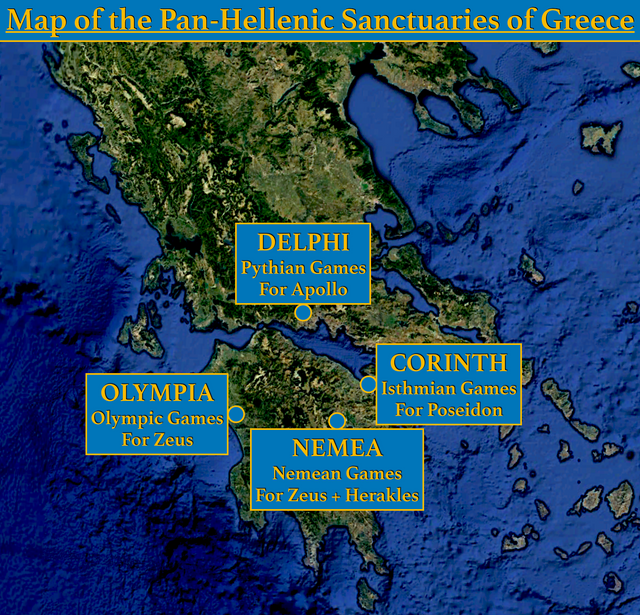
These were the four Crown Games. One of them will be familiar to you already:
• OLYMPIC GAMES
Surviving in a more modern form to this day, the Olympics are naturally the most well known of the Crown Games. The games were held in Olympia, and were dedicated to Olympia’s patron God, Zeus, king of the Gods. First started in 776 BC, they were originally intended to be festivals and celebrations of Zeus, but later had events added to these festivals like sprinting, javelin throwing and wrestling. All Greeks across the Greek world participated in these games, and they remained a tradition in Greece until the Roman period, when Theodosius I suppressed them in 393 AD, declaring them, as a Christian, as too Pagan. Olympic Games, like today, were held every 4 years in July/August, a period of time the Greeks would eventually call an “Olympiad”: four years. When the Olympics were to commence, an Olympic Truce was enacted, allowing other Greeks to pass through Olympia peacefully. This eventually would lead the games to be used more as a political tool used to assert dominance over rivals. Events included foot races (either regularly clothed or in full hoplite armour), horse racing, chariot racing, boxing, pankration (a Greek martial arts) and the pentathlon, the five events of which were wrestling, the long jump, foot races, discus throwing and javelin throwing. Winners at the Olympics would receive an olive wreath, called a Kotinos.
• PYTHIAN GAMES
The Pythian Games were established in 590 BC, and took place at Delphi, one of (if not, the) holiest site in ancient Greece. The Pythia was the high priestess at the temple of Apollo, and the games are named after this position; The games were dedicated to Apollo - patron of Delphi - every 4 years, two years before and after the Olympics, and winners of events here would receive a laurel wreath prize. Culminating the festival was done so with a display of an image of the gods to the worshippers, being mostly kept within the sanctuary of the city.
As a city, Delphi was constructed during the second half of the 7th century, on a site the Greeks believed to be the centre of the world, magnifying the religious significance of this site. It soon, therefore, became a major temple to the god of the sun, Apollo, Even during the Roman Era, hundreds of votive statues from the rest of the Roman-Greek world remained at Delphi.
Delphi’s sanctuary of Apollo was managed by the Amphictyony. This group consisted of 12 ethnē (tribes/communities), and each ethnos had two representatives - called hieromnēmones - on the Amphictyonic council. The Amphictyony had the power to declare a Sacred War, something they did three times in total, resulting in the three Sacred Wars (595 - 346 BC). The Amphictyonic’s core territories included the Thessalians, the Boeotians, the Dorians, the Ionians, the Perrhaebians, the Magnetes, the Dolopians, the Locrians, the Oetaeans, the Phthiotians, the Malians and the Phocians.
• ISTHMIAN GAMES
The Isthmian Games were held at Corinth, named so after the Isthmus of Corinth that the city lies upon and gave its name to. Isthmian games were dedicated to Corinth’s patron god, Poseidon, god of the sea, and were held every four years in April/May, originally beginning in the year 584 BC. Winners at these games received a wreath of celery, which was in later dates altered to have pine leaves on it too.
• NEMEAN GAMES
In mythology, Herakles is famous for completing his twelve labours given to him by Hera and Eurytheuses. One of his labours was to slay the Nemean Lion, a lion said to have impenetrable fur that ravaged the area around the city in the north-east Peloponnese. The games were said to be founded by Herakles, and also honour his father, Zeus. Unlike the other three games, the Nemean Games occurred every 2 years instead of four. Winners of the games received a wreath of wild celery leaves delivered from Argolis’ largest city, Argos.
SOURCES
• Early Greece, Second Edition, by Oswyn Murray
• Herodotus' Histories
• Greek History: War, Society and Change in the Archaic Age (CL1GH) lectures, by Professor Emma Aston, University of Reading
• Solinus, Wonders of the World, 7.14
All images used are either royalty free or were made by me
Digital Diogenes' Summary of the Greek Polis (I DO NOT own this video)
Congratulations @oo7harv! You have completed the following achievement on the Steem blockchain and have been rewarded with new badge(s) :
You can view your badges on your Steem Board and compare to others on the Steem Ranking
If you no longer want to receive notifications, reply to this comment with the word
STOPTo support your work, I also upvoted your post!
Do not miss the last post from @steemitboard:
Vote for @Steemitboard as a witness to get one more award and increased upvotes!